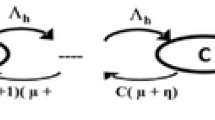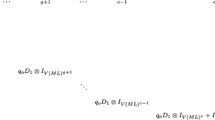Abstract
A scheme supporting voice and data calls with some grade of service (GoS)1 guarantee in mobile multiservice networks is proposed. In this system, voice calls have preemptive priority over data calls. Preempted data calls can wait in a queue for a random patience time after which they leave the queue. A data call can be preempted only if there is space left in the finite size queue. To assess the performance of this system, an analytical model is given and performance metrics such as call blocking, call dropping and call non‐completion probabilities are investigated. Although this scheme is a generic model, it can be easily adapted to take into account the specific definitions of practical and commercial data service standards in wireless mobile networks such as GPRS or DECT.
Similar content being viewed by others
References
J. Cai and D. Goodman, General packet radio service in GSM, IEEE Communications Magazine 35(10) (1997) 122–131.
C.J. Chang, T.T. Su and Y.Y. Chiang, Analysis of a cutoff priority cellular radio system with finite queueing and reneging/dropping, IEEE/ACM Transactions on Networking 2(3) (1994) 166–175.
J. Chen and M. Schwartz, Two-tier resource allocation for a multimedia micro-cellular mobile system: Performance summary, in: Proc. of IEEE PIMRC'95 (1995) pp. 1067–1072.
K.C. Chua, B. Bensaou, W. Zhuang and S.Y. Choo, Dynamic channel reservation (DCR) scheme for handoffs prioritization in mobile micro/picocellular networks, in: Proc. of IEEE ICUPC'98 (1998) pp. 383–387.
J.C.I. Chuang, Autonomous adaptive frequency assignment of TDMA portable radio systems, IEEE Transactions on Vehicular Technology 40(3) (1991) 627–635.
B. Epstein and M. Schwartz, Reservation strategies for multimedia traffic in a wireless environment, in: Proc. of 45th IEEE VTC (1995) pp. 165–169.
Y.B. Lin, S. Mohan and A. Noerpel, Queueing priority channel assignment strategies for handoff and initial access for a PCS network, IEEE Transactions on Vehicular Technology 43(3) (1994) 704–712.
Y.B. Lin, A. Noerpel and D. Harasty, The sub-rating channel assignment strategy for PCS hand-offs, IEEE Transactions on Vehicular Technology 45(1) (1996) 122–130.
R.J. Mulder, DECT, a universal cordless access system, Philips Telecommunications Review 49(3) (1991) 68–73.
M. Naghshineh and A.S. Acampora, QoS provisioning in micro-cellular networks supporting multimedia traffic, in: Proc. of IEEE INFOCOM'95, pp. 1075–1084.
S.S. Rappaport and C. Purzynski, Prioritized resource assignment for mobile cellular communication systems with mixed services and platform types, IEEE Transactions on Vehicular Technology 45(3) (1996) 443–457.
S. Tekinay and B. Jabbari, Handover policies and channel assignment strategies in mobile cellular networks, IEEE Communications Magazine 29(11) (1991) 42–46.
W. Zhuang, B. Bensaou and K.C. Chua, Adaptive quality of service handoff priority scheme for wireless mobile multimedia networks, IEEE Transactions on Vehicular Technology 49(2) (1999) 494–505.
Author information
Authors and Affiliations
Rights and permissions
About this article
Cite this article
Zhuang, W., Bensaou, B. & Chua, K.C. Handoff priority scheme with preemptive, finite queueing and reneging in mobile multiservice networks. Telecommunication Systems 15, 37–51 (2000). https://doi.org/10.1023/A:1019118223116
Issue Date:
DOI: https://doi.org/10.1023/A:1019118223116




